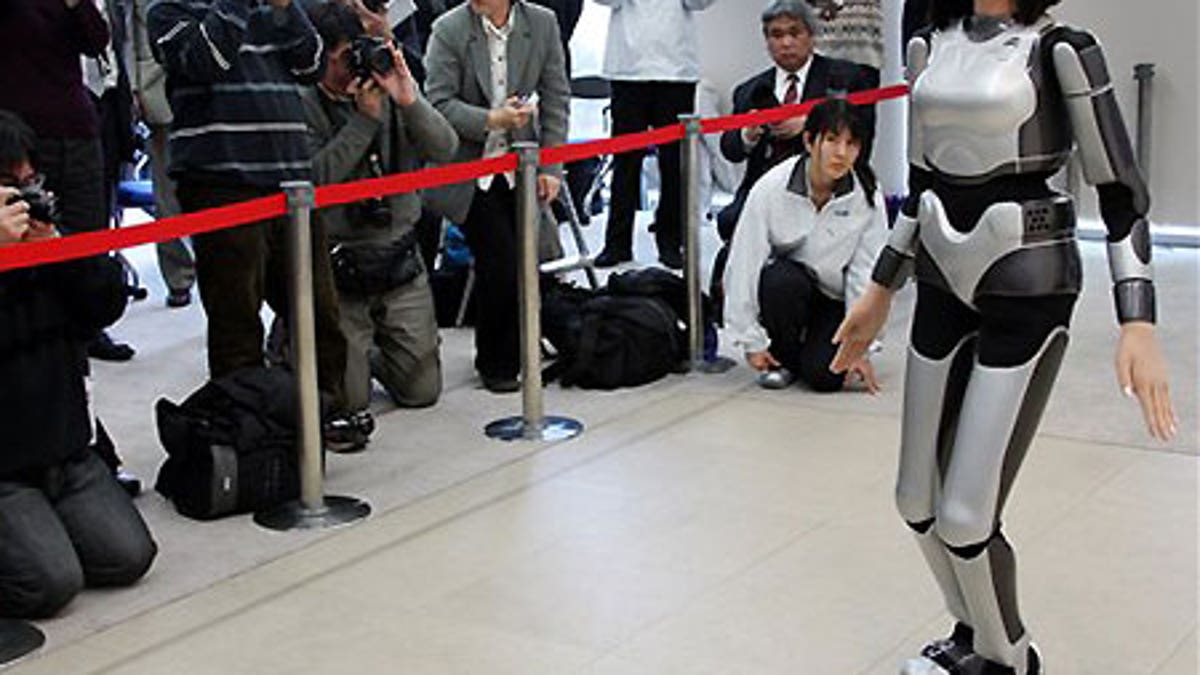
March 16: HRP-4C, designed to look like an average Japanese woman, meets the press during a demonstration in Tsukuba, near Tokyo. (AP)
TSUKUBA, Japan – A new walking, talking robot from Japan has a female face that can smile and has trimmed down to 43 kilograms (95 pounds) to make a debut at a fashion show. But it still hasn't even cleared safety standards to share the catwalk with human models.
Developers at the National Institute of Advanced Industrial Science and Technology, a government-backed organization, said their "cybernetic human," shown Monday, wasn't ready to help with daily chores or work side by side with people — as robotics has been billed to do in the future.
"Technologically, it hasn't reached that level," said Hirohisa Hirukawa, one of the robot's developers. "Even as a fashion model, people in the industry told us she was short and had a rather ordinary figure."
• Click here for FOXNews.com's Patents and Innovation Center.
Entertainment and drawing crowds are the main purpose for the 158 centimeter (62.2 inch) tall black-haired robot code-named HRP-4C, whose predecessor had weighed 58 kilograms (128 pounds).
Developers said the robot may be used in amusement parks, events to attract attention and simulations of human movement such as exercise instructor.
HRP-4C was designed to look like an average Japanese woman, although its silver-and-black body makes it appear to be wearing a space-suit. It will appear in a Tokyo fashion show, although without any clothes, in a special section just for the robot next week.
The robotic framework for the HRP-4C without the face and other coverings will go on sale for about 20 million yen ($200,000) each, and its programming technology will be made public so other people can come up with fun moves for the robot, the scientists said.
Japan boasts one of the leading robotics industries in the world, and the government is pushing to develop the industry as a road to growth. Automaker Honda Motor Co. has developed Asimo, which can walk and talk, although it doesn't pretend to look human.
Other robots, like the ones from Hiroshi Kobayashi at the Tokyo University of Science and Hiroshi Ishiguro at Osaka University, have more human-like faces and have been tested as receptionists.
But demands are growing for socially useful robots, such as those for caring for the elderly and the sick, said Yoshihiro Kaga, a government official in the trade and industry ministry.
"We want this market to grow as an industry," he said.
The robot shown Monday has 30 motors in its body that allows it to walk and move its arms as well as eight motors on its face to create expressions like anger and surprise.
In a demonstration for reporters, the robot waddled out, blinking, a bit like an animation figure come to life, and said, "Hello, everyone," in a tiny feminine voice while its mouth moved.
Its workings weren't perfect. It kept looking surprised, opening its mouth and eyes in a stunned expression, when the demonstrator had asked it to smile or look angry.
Its walk was also not quite ready for the Paris Collection, partly because it must keep its knees bent the whole time. It has sensors in its feet but lacks the sensitive balance of a real human.
The big challenge in creating HRP-4C was making the parts small so it looks female, especially its thinner legs, said Shuuji Kajita, who leads the institute's humanoid research group.
"But this is just the first step," he said.
